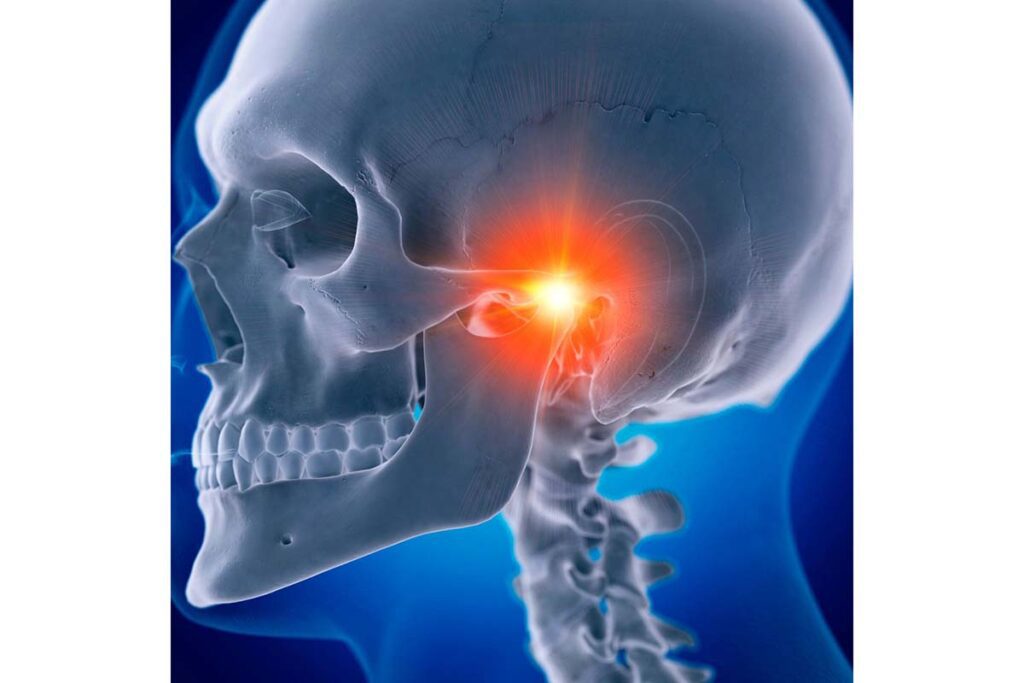TMJ disorders, involving the temporomandibular joint (TMJ), are more than just a dental concern – they’re a quality of life issue. This condition, affecting the jaw joint and muscles that control jaw movement, can lead to a range of symptoms, often misunderstood or overlooked.

Identifying TMJ Symptoms: More Than Just Jaw Pain
When it comes to TMJ disorders, symptoms can be varied and sometimes misleading. Of course, jaw pain is a key indicator, often centered around the jaw joints. However, the symptoms of TMJ can extend beyond this, including headaches, ear canal discomfort, and facial pain. It’s not just about the pain but also about functionality – difficulty in jaw movement, jaw locking, and a noticeable change in how the upper and lower teeth meet.

Common Causes of TMJ Disorders: From Stress to Jaw Injury
Understanding the causes of TMJ disorders is crucial in addressing them effectively. These disorders can stem from several factors, including physical stress on the jaw joints and jaw muscles, often caused by teeth grinding or clenching. Jaw injury, degenerative joint diseases like rheumatoid arthritis, and even genetic predisposition can play roles in the development of TMJ disorders.

The Impact of TMJ on Daily Life
TMJ disorders can significantly impact one’s daily life. From challenges in eating certain foods to disruptions in sleep due to jaw discomfort, the effects are profound and personal. Real stories from patients highlight the diverse ways in which these symptoms manifest and affect daily activities, underlining the importance of recognizing and addressing TMJ symptoms early.

Jaw Joint Discomfort: Recognizing Early Warning Signs
Early signs of TMJ disorders often involve discomfort in the jaw joint. This can range from a mild ache to a sharp pain when chewing, speaking, or even at rest. It’s important to be aware of these early signs, as timely intervention can prevent the progression of the disorder.
Teeth Grinding and TMJ: A Cyclical Problem
Teeth grinding, or bruxism, is both a symptom and a cause of TMJ disorders. This involuntary action, especially prevalent during sleep, puts excessive pressure on the jaw joints and muscles, exacerbating the condition. Addressing teeth grinding is a critical step in managing TMJ symptoms.
Facial Pain and TMJ: Beyond the Jaw Joint
Facial pain associated with TMJ disorders can extend beyond the immediate area of the jaw joints. This pain can manifest in the temples, around the ears, and even down the neck, often misattributed to other conditions.
How Your Habits Influence Symptoms
Lifestyle factors play a significant role in the management of TMJ disorders. Poor posture, stress, and dietary habits can all influence TMJ symptoms. Implementing positive lifestyle changes can help alleviate some of these symptoms and improve overall well-being.

TMJ/TMD by the Numbers: Understanding the Prevalence and Impact
When it comes to TMJ/TMD, the numbers speak volumes about its prevalence and impact on individuals. Let’s dive into some key statistics:
- Prevalence in the Population: The National Institute of Dental and Craniofacial Research (NIDCR) estimates that over 10 million Americans are affected by TMJ disorders. This statistic highlights the widespread nature of these conditions.
- Gender Disparity: TMJ disorders are more common in women than men. Women are over twice as likely to suffer from these conditions, especially during their childbearing years, according to New York Dynamic Neuromuscular Rehabilitation & Physical Therapy,
- Impact on Quality of Life: Patients with TMJ disorders often experience significant impairments in their quality of life, including limitations in jaw function and chronic pain, as noted in the National Library of Medicine.
- Association with Other Health Issues: A correlation between TMJ disorders and other chronic pain conditions, such as fibromyalgia and chronic fatigue syndrome, suggests a broader impact on overall health according to VeryWell health.
- Symptom Frequency: As per the Sage Journals, the most commonly reported symptoms of TMJ disorders include headaches (reported by 49.6% of patients), followed by jaw pain (25.2%), and joint noise or clicking (28%).
By understanding these statistics, we gain a clearer picture of the prevalence, impact, and challenges associated with TMJ/TMD. This information not only aids in awareness but also emphasizes the importance of seeking timely and effective treatment.

Seeking Professional Help: When to Consult a Healthcare Provider
It’s crucial to seek professional help when TMJ symptoms persist or worsen. Healthcare providers can offer a range of treatments, from physical therapy and pain relief strategies to more advanced options like mouth guards or prescription medications.
Living with TMJ disorders can be challenging, but understanding the symptoms, causes, and treatment options is the first step towards finding relief. Through this guide, we hope to shed light on this often misunderstood condition, encouraging those affected to seek the help they need and find ways to improve their quality of life.
